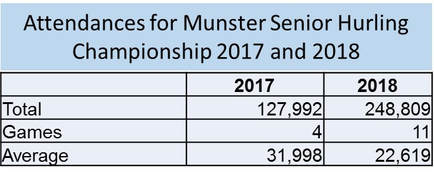Many team sporting competitions end with a knock-out component. The round-robin gives fixity-of-fixtures and the knockout element helps build excitement for the fans.
The purpose of this post is to quantify the implication for spectators numbers, i.e. those passing through the turnstiles (TV audiences are another matter). What follows are the numbers for the Munster senior hurling competition. A similar analysis can be performed for the Leinster competition.
The 2018 change to the competition structure of the Munster Senior Hurling Championship had the expected impact on attendances. By moving to a round-robin structure the number of games increased and so too did the total attendance. The 2017 competition had 4 games, namely, a quarter-final, two semi-finals, and a final. A total of 127,992 spectators passed through the turnstiles. The 2018 competition had 11 games. There were 10 round-robin games and a final. There were 248,809 spectators for these 11 games. The average number of spectators per game declined while the overall numbers increased.
The change "worked" in Munster because the county teams are close to each other on the field and geographically. The experiment is likely to survive. The evidence is less clear cut for the new football round-robin.

 RSS Feed
RSS Feed